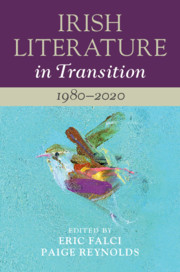Book contents
- Irish Literature in Transition, 1980–2020
- Irish Literature in Transition
- Irish Literature in Transition, 1980–2020
- Copyright page
- Contents
- Contributors
- Series Preface
- General Acknowledgements
- Acknowledgements
- Introduction
- Part I Times
- Part II Spaces
- Part III Forms of Experience
- Part IV Practices, Institutions, and Audiences
- Chapter 16 Mediation and Translation in Irish Language Literature
- Chapter 17 Irish Studies and Its Discontents
- Chapter 18 Historical Transitions in Ireland on Screen
- Chapter 19 Irish Blockbusters and Literary Stars at the End of the Millennium
- Chapter 20 Contemporary Literature and Public Value
- Coda: The Irish Times, Tramp Press, and the Future Present
- Index
Chapter 18 - Historical Transitions in Ireland on Screen
from Part IV - Practices, Institutions, and Audiences
Published online by Cambridge University Press: 28 February 2020
- Irish Literature in Transition, 1980–2020
- Irish Literature in Transition
- Irish Literature in Transition, 1980–2020
- Copyright page
- Contents
- Contributors
- Series Preface
- General Acknowledgements
- Acknowledgements
- Introduction
- Part I Times
- Part II Spaces
- Part III Forms of Experience
- Part IV Practices, Institutions, and Audiences
- Chapter 16 Mediation and Translation in Irish Language Literature
- Chapter 17 Irish Studies and Its Discontents
- Chapter 18 Historical Transitions in Ireland on Screen
- Chapter 19 Irish Blockbusters and Literary Stars at the End of the Millennium
- Chapter 20 Contemporary Literature and Public Value
- Coda: The Irish Times, Tramp Press, and the Future Present
- Index
Summary
This chapter uses a chronological framework to explore a number of transitions in the development of cinema in Ireland, giving particular attention to the period from the mid-1990s to the present. By connecting the idea of ‘transition’ to the term ‘borrowing’, the chapter uses the latter to explore how the evolution of indigenous film-making was often suspended between established historical precedents and moments of definitive transition. In this, it proposes an affirmative reading of how Irish film-makers carved out an important niche in the interstices between more traditional and contemporary cultural, political, industrial, and aesthetic practices: on the one hand by acknowledging existing templates, and on the other by creatively exploring certain elasticity within the same structures. This ingenuity is evident across a formal play with genres, the creative use of literary sources, an address to earlier representations of Ireland on screen, and (more recently) through technological developments in distribution.
- Type
- Chapter
- Information
- Irish Literature in Transition: 1980–2020 , pp. 344 - 359Publisher: Cambridge University PressPrint publication year: 2020

